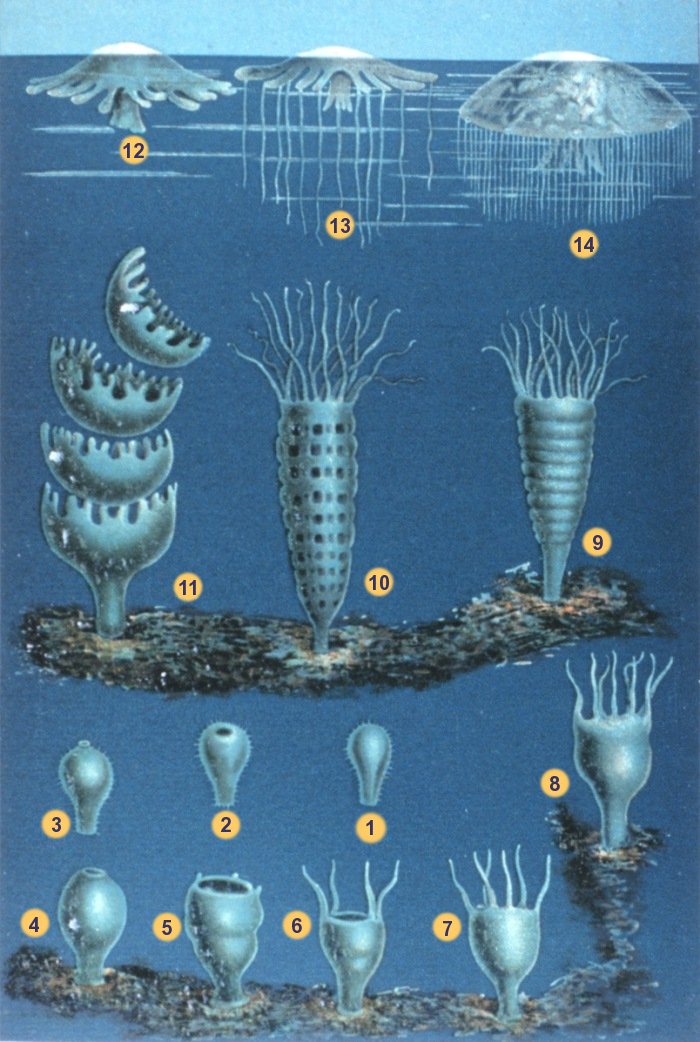
1–3 Larva searches for site:
Upon reaching adult size, jellyfish spawn regularly if there is a sufficient supply of food. In most species, spawning is controlled by light, with all individuals spawning at about the same time of day; in many instances this is at dawn or dusk.[51] Jellyfish are usually either male or female (with occasional hermaphrodites). In most cases, adults release sperm and eggs into the surrounding water, where the unprotected eggs are fertilized and develop into larvae. In a few species, the sperm swim into the female's mouth, fertilizing the eggs within her body, where they remain during early development stages. In moon jellies, the eggs lodge in pits on the oral arms, which form a temporary brood chamber for the developing planula larvae.[52]
4-8 Polyp grows:
The planula is a small larva covered with cilia. When sufficiently developed, it settles onto a firm surface and develops into a polyp. The polyp generally consists of a small stalk topped by a mouth that is ringed by upward-facing tentacles. The polyps resemble those of closely related anthozoans, such as sea anemones and corals. The jellyfish polyp may be sessile, living on the bottom, boat hulls or other substrates, or it may be free-floating or attached to tiny bits of free-living plankton[53] or rarely, fish[54][55] or other invertebrates. Polyps may be solitary or colonial.[56] Most polyps are only millimetres in diameter and feed continuously. The polyp stage may last for years.[24]
9-11 Polyp strobilates:
After an interval and stimulated by seasonal or hormonal changes, the polyp may begin reproducing asexually by budding and, in the Scyphozoa, is called a segmenting polyp, or a scyphistoma. Budding produces more scyphistomae and also ephyrae.[24] Budding sites vary by species; from the tentacle bulbs, the manubrium (above the mouth), or the gonads of hydromedusae.[53] In a process known as strobilation, the polyp's tentacles are reabsorbed and the body starts to narrow, forming transverse constrictions, in several places near the upper extremity of the polyp. These deepen as the constriction sites migrate down the body, and separate segments known as ephyra detach. These are free-swimming precursors of the adult medusa stage, which is the life stage that is typically identified as a jellyfish.[24][57] The ephyrae, usually only a millimeter or two across initially, swim away from the polyp and grow. Limnomedusae polyps can asexually produce a creeping frustule larval form, which crawls away before developing into another polyp.[24]
12-14 Medusa grows:
A few species can produce new medusae by budding directly from the medusan stage. Some hydromedusae reproduce by fission.[53]
Lifespan
Little is known of the life histories of many jellyfish as the places on the seabed where the benthic forms of those species live have not been found. However, an asexually reproducing strobila form can sometimes live for several years, producing new medusae (ephyra larvae) each year.[58]
An unusual species, Turritopsis dohrnii, formerly classified as Turritopsis nutricula,[59] might be effectively immortal because of its ability under certain circumstances to transform from medusa back to the polyp stage, thereby escaping the death that typically awaits medusae post-reproduction if they have not otherwise been eaten by some other organism. So far this reversal has been observed only in the laboratory.[60]
Diet
Jellyfish are like other cnidarians generally carnivorous (or parasitic),[65] feeding on planktonic organisms, crustaceans, small fish, fish eggs and larvae, and other jellyfish, ingesting food and voiding undigested waste through the mouth. They hunt passively using their tentacles as drift lines, or sink through the water with their tentacles spread widely; the tentacles, which contain nematocysts to stun or kill the prey, may then flex to help bring it to the mouth.[24] Their swimming technique also helps them to capture prey; when their bell expands it sucks in water which brings more potential prey within reach of the tentacles.
A few species such as Aglaura hemistoma are omnivorous, feeding on microplankton which is a mixture of zooplankton and phytoplankton (microscopic plants) such as dinoflagellates.[67] Others harbour mutualistic algae (Zooxanthellae) in their tissues;[24] the spotted jellyfish (Mastigias papua) is typical of these, deriving part of its nutrition from the products of photosynthesis, and part from captured zooplankton.[68][69]